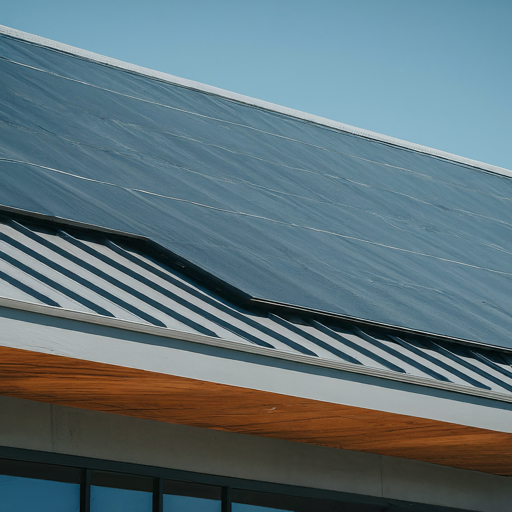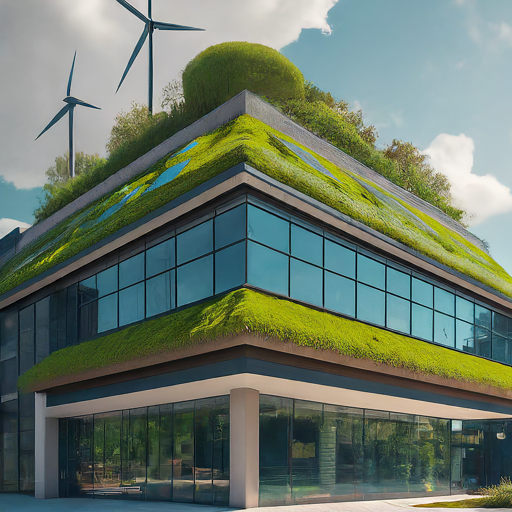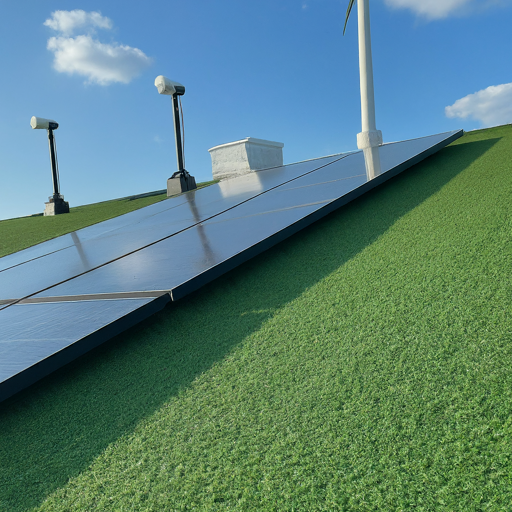Sustainable Roofing: A Commercial Game-Changer
Introduction

Commercial buildings play a significant role in shaping our urban landscapes and resource consumption. As we strive towards a more sustainable future, the roofing systems on these structures hold immense potential for positive change. This blog delves into the critical importance of sustainable roofing in commercial buildings and explores the exciting advancements and benefits it offers.
Importance of Sustainable Roofing in Commercial Buildings
- Environmental Impact: Conventional roofing materials often contribute to environmental issues like the urban heat island effect, resource depletion, and landfill waste. Sustainable roofing solutions address these concerns by:
- Reducing Energy Consumption: Utilizing reflective materials and cool roofing technologies can significantly lower the demand for air conditioning, leading to decreased energy usage and greenhouse gas emissions.
- Minimizing Waste: Sustainable roofing materials often incorporate recycled content and are designed for long lifespans, reducing the overall environmental footprint associated with roof replacements.
- Enhancing Stormwater Management: Green roofs and other sustainable systems can capture and filter rainwater, mitigating the burden on stormwater infrastructure and promoting water conservation.
- Economic Benefits: Beyond environmental advantages, sustainable roofing offers compelling economic benefits for commercial property owners:
- Cost Savings: Energy-efficient roofing systems translate to lower energy bills over time. Additionally, the durability and low maintenance requirements of sustainable materials can significantly reduce long-term repair and replacement costs.
- Increased Property Value: Buildings with sustainable features are increasingly attractive to tenants and investors, potentially leading to higher rental rates and property values.
Overview of the Blog’s Focus
This blog will serve as a comprehensive guide to sustainable roofing in commercial settings. We will explore various aspects of this transformative approach, including:
- Types of Sustainable Roofing Materials and Technologies: From cool roofs and green roofs to solar panels and reflective membranes, we will delve into the diverse options available.
- Benefits and Considerations for Implementing Sustainable Roofing: We will analyze the economic and environmental advantages, along with practical considerations like initial investment costs and maintenance requirements.
- Case Studies and Success Stories: Showcasing real-world examples of successful sustainable roofing projects in commercial buildings, highlighting the tangible benefits achieved.
By providing valuable insights and practical information, this blog aims to empower building owners, architects, and facility managers to embrace sustainable roofing practices and contribute to a more responsible and eco-friendly built environment.
Understanding Sustainable Roofing

Sustainable roofing goes beyond just aesthetics; it’s a comprehensive approach that prioritizes the environment and long-term benefits for commercial buildings. This philosophy is characterized by three key principles:
Environmentally Friendly Materials
Sustainable roofing emphasizes the use of materials with minimal environmental impact throughout their lifecycle. This includes:
- Recycled Content: Utilizing materials like (recycled asphalt roofing) or shingles made from (recycled rubber) or (plastic) significantly reduces the need for virgin resources.
- Renewable Resources: Opting for wood roofing sourced from sustainably managed forests or (thatch roofing) made from natural materials like straw or reeds minimizes environmental footprint.
- Low Embodied Energy: Materials like metal roofing or (slate roofing) require less energy during production compared to traditional options like concrete roofing.
Energy Efficiency Considerations
Sustainable roofing actively reduces energy consumption within a building:
- Cool Roofs: These roofs, often featuring (reflective membranes) or (light-colored tiles), reflect sunlight and heat away from the building, significantly lowering the demand for air conditioning and reducing energy usage.
- Solar Rntegration: Incorporating solar shingles into the roof design allows for harnessing renewable energy, further contributing to energy independence.
Long-term Sustainability Benefits

Sustainable roofing solutions are designed for longevity and minimal environmental impact:
- Durability: Materials like metal roofing, tile roofing, and (slate roofing) boast extended lifespans, minimizing the need for frequent replacements and associated waste generation.
- Low Maintenance: Sustainable materials often require less maintenance compared to traditional options, reducing overall resource consumption and environmental burden.
- Water Management: Green roofing and other sustainable systems play a crucial role in stormwater management by capturing and filtering rainwater, reducing strain on infrastructure and promoting water conservation.
By adhering to these principles, sustainable roofing offers a win-win situation for both the environment and building owners, paving the way for a more responsible and eco-friendly future.
Benefits of Sustainable Roofing for Commercial Buildings

Sustainable roofing offers a multitude of advantages that extend far beyond aesthetics, delivering significant environmental and economic benefits for commercial buildings.
Environmental Impact Reduction
- Reduced Carbon Footprint: Sustainable materials and energy-efficient features like cool roofs and solar integration contribute to a lower overall carbon footprint for the building. This translates to reduced greenhouse gas emissions and a positive impact on climate change.
- Stormwater Management: Green roofs and other sustainable systems play a crucial role in managing stormwater. By capturing and filtering rainwater, they reduce the burden on stormwater infrastructure, prevent flooding, and promote water conservation.
- Urban Heat Island Effect Mitigation: Cool roofs and reflective surfaces significantly reduce the amount of heat absorbed by buildings, mitigating the urban heat island effect. This leads to lower ambient temperatures in urban areas, improving overall air quality and human comfort.
Cost Savings and ROI
- Energy Savings: Sustainable roofing solutions like cool roofs and solar panels significantly reduce energy consumption for heating and cooling, leading to substantial cost savings on utility bills over time.
- Extended Roof Lifespan: Sustainable materials like metal roofing and slate boast extended life spans compared to traditional options. This translates to fewer roof replacement and associated costs throughout the building’s life cycle.
- Potential Tax Incentives and Rebates: Many government agencies and utility companies offer tax incentives and rebates to encourage the adoption of sustainable roofing practices. This can significantly offset the initial investment costs associated with roofing work.
Investing in sustainable roofing goes beyond just environmental responsibility; it’s a strategic decision with tangible financial benefits. By reducing energy consumption, extending roof lifespan, and potentially capitalizing on financial incentives, sustainable roofing delivers a strong return on investment (ROI) for building owners.
It’s crucial to remember that regular roof inspection are essential for maintaining the integrity and performance of any roof, regardless of the material used. Early detection of potential damage signs through regular inspections allows for timely repairs and extends the overall lifespan of the roof, further contributing to cost savings. Additionally, proper roof care practices, like scheduled maintenance and cleaning, are essential for maximizing the benefits and longevity of any roofing system.
Types of Sustainable Roofing Systems
Sustainable roofing encompasses various innovative solutions that prioritize environmental benefits and long-term performance. Here, we delve into two prominent categories:
Green Roofing Solutions
Green roofing refers to a system where a layer of vegetation is established on a rooftop. This creates a living ecosystem that offers a multitude of advantages:
Definition and Benefits
- Reduced Urban Heat Island Effect: Green roofs absorb solar radiation and release moisture through evapotranspiration, lowering the surrounding air temperature and mitigating the urban heat island effect.
- Stormwater Management: Green roofs act as natural sponges, absorbing and filtering rainwater, reducing runoff and strain on stormwater infrastructure.
- Improved Air Quality: Green roofs absorb pollutants and dust, contributing to cleaner air and a healthier environment.
- Biodiversity Enhancement: Green roofs provide habitat for insects, birds, and other wildlife, promoting biodiversity in urban areas.
- Aesthetic Appeal: Green roofs create a visually pleasing and functional green space in the midst of urban landscapes.
Types of Green Roof Systems
- Extensive Green Roofs: These lightweight systems feature low-growing plants like sedum and mosses, requiring minimal maintenance and being suitable for most roof shapes like flat roof and gabled roof.
- Intensive Green Roofs: These deeper systems can support a wider variety of plants, including shrubs and small trees. However, they require a more robust structural support system and are typically suited for (flat roofs) with a strong carrying capacity.
Installation and Maintenance Considerations
- Structural Support: The building structure needs to be assessed to ensure it can handle the additional weight and potential water load of a green roof.
- Underlayments: A waterproof membrane like ice water barrier is crucial to protect the building structure from moisture.
- Drainage System: A well-designed drainage system is essential to prevent waterlogging and ensure proper water flow.
- Insulation: Adequate insulation below the green roof system is crucial for maintaining building energy efficiency.
- Coverboards: Lightweight and durable coverboards are used to protect the waterproofing layer and create a stable base for the planting medium.
- (Materials): Selecting suitable (materials) for each layer, considering factors like weight, drainage, and compatibility with the chosen vegetation, is essential.
- Maintenance: Regular maintenance is required for tasks like weeding, watering (especially during dry periods), and monitoring plant health.
Cool Roofing Technology
Cool roofing technology utilizes reflective and emissive materials to minimize heat absorption by the building, leading to significant energy savings.
Reflective and Emissive Materials
- Reflective Materials: These materials, often light-colored or incorporating (metal roofing), have a high solar reflectance index (SRI), reflecting sunlight and heat away from the building.
- Emissive Materials: Certain cool roofing materials also boast high emissivity, readily releasing absorbed heat back into the atmosphere, further contributing to cooler roof temperatures.
Energy-Saving Benefits
By reflecting and emitting heat, cool roofs significantly reduce the demand for air conditioning, leading to substantial energy cost savings, particularly in hot climates. This translates to a lower carbon footprint and a more sustainable building operation.
Application in Various Climates
Cool roofing technology is particularly beneficial in hot and sunny climates where air conditioning usage is high. However, even in moderate climates, cool roofs can contribute to energy savings and improved building comfort.
It’s important to note that the effectiveness of cool roofing materials can vary depending on the specific climate and overall building design factors like roof shapes. For instance, pitched roof with a steeper slope might benefit more from cool roofing compared to flat roof.
Implementing Sustainable Roofing in Commercial Settings
Transitioning to sustainable roofing requires careful consideration of various factors that influence the design, installation, and overall success of the project. Here are some key aspects to keep in mind:
Factors to Consider in Roofing Design and Installation
Building Orientation and Climate Considerations
- Solar Exposure: The amount of direct sunlight the roof receives significantly impacts the choice of sustainable solutions. Cool roofing materials might be more beneficial in hot climates with high solar exposure, while green roofs might be more suitable in areas with moderate temperatures and sufficient rainfall.
- Wind and Precipitation: The local wind patterns and precipitation levels influence the selection of materials and the design of the roof system to ensure proper drainage and withstand potential weather events.
Local Regulations and Building Codes
- Building codes often mandate specific requirements for roof materials, installation methods, and safety features. It’s crucial to adhere to all local regulations to ensure the project complies with legal standards.
- Certain regions might offer incentives or tax breaks for adopting sustainable roofing practices. Understanding these regulations can help optimize the project’s financial feasibility.
Budgetary Constraints and Financing Options
- Sustainable roofing materials and technologies often come with a higher initial investment compared to traditional options. However, the long-term cost savings through energy efficiency, extended lifespan, and potential financial incentives can significantly offset the initial costs.
- Exploring financing options like green loans or rebates offered by government agencies or utilities can help make sustainable roofing more accessible.
Additional Considerations
- Existing Roof Condition: Evaluating the condition of the existing roof structure is crucial to determine if it can support the additional weight and potential modifications required for sustainable solutions like green roofs or solar panel installations. Addressing any existing issues like roof damage caused by factors like fungus mold, time aging, sun heat, hail lightning, cold ice, or water leaks is essential before implementing sustainable upgrades.
- Maintenance Requirements: Different sustainable roofing systems have varying maintenance needs. Green roofs require regular weeding, watering, and monitoring plant health, while cool roofs might require periodic cleaning to maintain their reflectivity. Understanding these requirements is essential for ensuring the long-term performance and benefits of the chosen system.
By carefully considering these factors and seeking guidance from qualified professionals like architects, engineers, and roofing contractors specializing in sustainable solutions, building owners can make informed decisions and successfully implement sustainable roofing practices in their commercial settings.
Future Trends and Innovations in Sustainable Roofing


The future of sustainable roofing holds immense promise, with exciting advancements poised to revolutionize the industry:
Advancements in Green Roof Technology
- Integration with Renewable Energy Systems: Green roofs can be combined with solar panels or small wind turbines, creating self-sustaining micro-power grids that generate clean energy for the building.
- IoT and Smart Roof Management: Sensor networks embedded within green roofs can monitor moisture levels, plant health, and potential issues, enabling real-time data analysis and automated maintenance through the Internet of Things (IoT).
Adoption of Sustainable Roofing Practices
- Growing Awareness and Demand: As the environmental benefits of sustainable roofing become increasingly recognized, demand for these solutions will continue to rise, driving innovation and cost reductions.
- Industry Initiatives and Certifications: Established programs like LEED (Leadership in Energy and Environmental Design) and Energy Star will continue to play a crucial role in promoting and standardizing sustainable roofing practices within the construction industry.
These advancements, coupled with growing awareness and industry support, paint a bright future for sustainable roofing. As technologies evolve and costs become more competitive, we can expect widespread adoption of these solutions, creating a more sustainable and environmentally responsible built environment.
Conclusion
Sustainable roofing has emerged as a transformative force in the commercial building industry, offering a path towards a more environmentally responsible and resource-efficient future. This approach goes beyond aesthetics, delivering a multitude of benefits that span environmental impact reduction, significant cost savings, and long-term building performance.
From mitigating the urban heat island effect and managing stormwater runoff to reducing energy consumption and enhancing air quality, sustainable roofing solutions demonstrably contribute to a healthier planet and more sustainable built environment.
Businesses have a crucial role to play in embracing this shift. By exploring the diverse options available, from cool roofing technologies to green roof systems, companies can unlock the potential of sustainable roofing to achieve both environmental and economic gains.
As research and innovation continue to drive advancements in materials, technologies, and design, the future of sustainable roofing promises even greater benefits. By actively engaging in this evolving landscape, businesses can ensure they are at the forefront of responsible building practices, contributing to a more sustainable future for generations to come.
